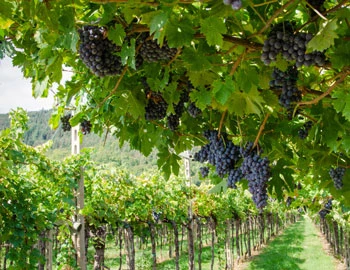Nyetimber
For the last quarter-century, England has played a very special role in the world of wines – an exotic in moist and chilly northern Europe.
When you think of England you might think of umbrellas, charm, and bowler hats. Specifically umbrellas, since British weather is famously rainy. Few people know that winegrowing in England is historically documented back to the 7th century. Thanks to the Gulf Stream, the climate is mild enough for certain types of grapes to grow and fully ripen. The change in climate during recent decades has brought some advantages to English winemakers, improving growth conditions and encouraging many to try their luck at winegrowing.
Sparkling wines from Nyetimber
from Nyetimber
Nyetimber was founded as a winery in 1988. However, the estate is much older; it was first mentioned in the Domesday Book (a famous land registry) in 1086. Embedded in the peaceful green landscape of West Sussex, with its carefully restored medieval buildings and houses, Nyetimber is a small gem that can transfer us into a far distant era.
Nyetimber was the first winery in England to grow champagne grape varieties such as Chardonnay, Pinot Noir, and Pinot Meunier, all with the aim of producing the best English sparkling wine through respecting the “méthode traditionnelle”. In the early 1990s, the first bottle left the winery and even beat some champagnes in various competitions.
The winegrowers Cherie Spriggs and her husband Brad Greatrix, both with international experience, have been responsible for all steps of the wine production since 2007. 170 hectares of grapes grow on eight different south-facing sites in Sussex and Hampshire on precious chalk soil similar to that found in the Champagne. Ever since the couple arrived at Nyetimber, they have worked to improve production processes. The inventory of reserve wines was and will be increased on a regular basis in order to create a non-vintage Classic Cuvée according to the Champagne model. At the other end of the production line is the Tillington Single Vineyard, the first English vintage sparkling wine from a single vineyard. A Rosé Non-Vintage and a Blanc de Blancs that will only be bottled during the best Chardonnay years, supplement this extraordinary sparkling wine experience.
Learn more about Nyetimber in this video: Master Class Series: Brad Greatrix (Winemaker) and Marc Almert (Chef Sommelier Baur au Lac and Baur au Lac Vins and ASI Best Sommelier of the World 2019)

Producer

Massena / Jaysen Collins
Dan Standish and Jaysen Collins were college friends, and in the late 1990s they decided to put their talents together to produce wine. Recently, Jaysen Collins has taken charge of the "Massena" project on his own.The grapes are purchased from growers in Greenock, Kalimna and Koonunga Hill in the northwest Barossa Valley.

Casa Lupo by Paladin
Casa Lupo is the Paladin family’s Valpolicella “subsidiary” and consists of 25 hectares spread between the towns of Negrar and Illasi in the province of Verona.

Sette Cieli
It isn’t easy to ascend to seventh heaven. And indeed, the road to the wine estate Sette Cieli is fraught with some difficulties. You might need to take a few detours (seventh heaven isn’t on Google Maps’ radar), but the Ratti family’s wine paradise is more than worth the effort.






